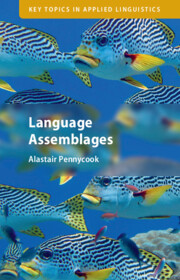Book contents
- Language Assemblages
- Key Topics in Applied Linguistics
- Language Assemblages
- Copyright page
- Contents
- Acknowledgements
- 1 Why Language Assemblages?
- 2 Language, Knowledge, Myths and Being
- 3 Structures and Practices
- 4 Linguistic, Semiotic and Sociomaterial Assemblages
- 5 Other Language Ontologies
- 6 Applied Linguistics as Practical Assemblage
- Suggested readings
- Glossary
- References
- Index
3 - Structures and Practices
Published online by Cambridge University Press: 20 June 2024
- Language Assemblages
- Key Topics in Applied Linguistics
- Language Assemblages
- Copyright page
- Contents
- Acknowledgements
- 1 Why Language Assemblages?
- 2 Language, Knowledge, Myths and Being
- 3 Structures and Practices
- 4 Linguistic, Semiotic and Sociomaterial Assemblages
- 5 Other Language Ontologies
- 6 Applied Linguistics as Practical Assemblage
- Suggested readings
- Glossary
- References
- Index
Summary
For much of its modern history, linguistics has taken an ontological stance on language as a structural entity, with a wide set of implications for how languages are understood as bounded entities. This is not about the different epistemological approaches to a structural version of language taken by various schools of linguistics, but about the basic ontological assumptions about what language is. A structural ontology made it possible to treat language as an object amenable to scientific study, enabling descriptions of languages around the world and facilitating many advances in our understandings of languages as structural entities. Yet this very tendency towards seeing languages as autonomous systems has enabled those forms of thinking that emphasize boundedness. When we contrast a structural ontology with a practice ontology, where the focus is on what people do with available linguistic resources, it becomes clear that in some of the recent translanguaging debates, people are talking about different things, language as structure and language as practice. Because structural and social (practice) language ontologies are so different, the debates about translanguaging have become mired in misunderstandings.
- Type
- Chapter
- Information
- Language Assemblages , pp. 50 - 80Publisher: Cambridge University PressPrint publication year: 2024

